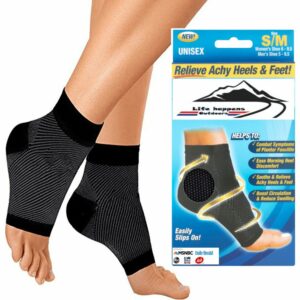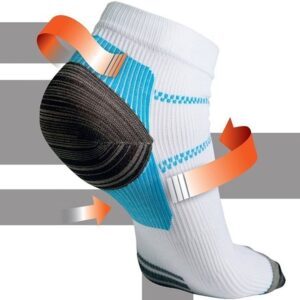It may be that you’ve had unstable ankles for years. You’re prone to twisting your ankles, spraining them or maybe your foot just rolls when you walk. Some people are born with ankles that don’t move in a healthy way – other people have unstable ankles due to injury or repetitive stress.
Can you correct unstable ankles without surgery? Do you need physical therapy? If you’ve got unstable ankles, you may have a number of questions. Let’s look at what unstable ankles are, and how you can treat them.
Why Do I Have Unstable Ankles?
“Why me”” you may ask. “What did I do to deserve this?!”
Relax, Max! You didn’t do anything wrong. Unstable ankles are caused by any number of things, from bone construction to injury. More often than not, unstable ankles are caused by old sprains that didn’t heal properly. Keep in mind, these injuries could have occurred as far back as when you were a kid! You’ll still feel the symptoms today, and may suffer some side effects, too.
People with ankle instability will be more prone to rolling their feet when they walk or run. That can lead to ankle twisting, or even tripping. Of course, tripping and twisting can ultimately lead to more injuries, so it’s important to address your unstable ankles before further damage is done.
People who have unstable ankles also may have trouble when they’re working out, or when they’re lifting objects. In fact, one of the symptoms of unstable ankles is the feeling that your ankles or legs are about to “give out.” This is a feeling that occurs in the actual bones, as opposed to a feeling like muscle fatigue.
If you have unstable ankles, it’s not uncommon to experience discomfort. You may have soreness around your feet and ankles, or even in other parts of your body as you overcompensate. Your ligaments are weaker than the norm if you have unstable ankles, and that can cause pain and inflammation after activity.
Pretty sure you have unstable ankles, and want to deal with them? Keep reading!
Dealing with Pain from Unstable Ankles
When you’re experiencing pain as a result of unstable ankles, there’s a good chance you may feel inclined to seek medical attention. That’s never a bad idea, but there’s a really good chance you don’t actually need to.
If you haven’t suffered an injury lately – say, twisting your ankle playing basketball, or tripping while you run – you probably don’t need a doctor’s visit just yet. The first thing you should do is, simply, get off your ankle.
You’ve probably heard of the RICE treatment. RICE stands for Rest, Ice, Compression, Elevation. All are good steps to take when you’re dealing with ankle pain. Get off your feet, put on an ice pack and elevate your legs. Get a good pair of compression socks to help prevent swelling and to keep inflammation down.
But there’s more you can do. You can take an over the counter anti-inflammatory, like ibuprofen, to keep the pain at bay and reduce swelling. If you do need to be on your feet for some reason, be sure to use orthotic insoles to keep your feet steady and prevent your ankles from twisting.
The pain associated with unstable ankles can be intense. If you feel that it’s too intense, or that something’s just “not right,” then by all means, consult a doctor.
Preventing Unstable Ankles
The best way to eliminate pain from unstable ankles is, well, to not have unstable ankles in the first place. Of course, as mentioned, that can’t always be helped. But you can certainly take steps to prevent injury, and to prevent further stress to unstable ankles.
The first thing you’ll need to do is invest in a good pair of orthotic insoles. In fact, invest in orthotic insoles for every pair of shoes you own. Orthotic insoles are like a miracle worker for people with unstable ankles. They’ll keep your feet from twisting, and will correct your pronation. In other words, they’re a lifesaver!
The next thing you’ll do is get an ankle brace. That’s a good solution, in particular, if your ankles feel particularly weak during the day. You may feel unsteady on your feet at times, or may feel that you’re favoring one leg over another. An ankle brace will support you properly, preventing injury.
Even beyond these tools, there are actions you can take to protect your ankles and prevent injury and pain. The easiest thing you can possibly do is just to improve your strength and flexibility. Every day, commit to doing a few exercises to strengthen your ankles and improve flexibility. These don’t require much effort – you can do them while you’re watching Netflix!
Exercises to Strengthen Ankles
A simple Google search will result in hundreds of ways you can strengthen your ankles and improve flexibility. Here are a few of our favorites.
- While you’re sitting on a chair, slip an exercise bank under your feet, right at the ball of your feet. Then, gently pull the band toward you. Flexing at the ankle, use your foot to push the band away from your body, then release. Repeat 15 times.
- You can do this exercise anywhere, even while you’re at work! All you’ll need to do is pretend you’re writing the ABCs with your toes. Use your foot to trace the letters of the alphabet – or shapes, or numbers… whatever you want!
- Do toe lifts. Standing with your weight evenly distributed between both feet, slowly raise up to tippy-toe position. This exercise will not only improve your ankle strength but will also help to improve your balance.
Whichever ankle exercises you choose to do, it’s important that you be mindful of your physical health. For example, if you’ve recently sprained your ankle, it’s probably best to do seated exercises. As always, if you’ve got any questions at all, just call your doctor!
Here are some great products to support and stabilize your ankles:
-
50 %OFF50 %OFF50 %OFF50 %OFF
Pain Relief Foot Compression Socks
Rated 4.43 out of 5$39.99Original price was: $39.99.$19.99Current price is: $19.99. Select options -
33 %OFF33 %OFF33 %OFF
Heel, Ankle & Achilles Pain Management Socks
Rated 4.57 out of 5$29.99Original price was: $29.99.$19.99Current price is: $19.99. Select options -
Professional Calf Compression Socks
Rated 4.67 out of 5$22.99 Select options -
Extreme Ankle Brace
Rated 4.69 out of 5$29.90 Add to cart




















One Response
Hi, I would like to tell that the grade of compression is absolutely perfect. I was skeptical but these really work. Thank you